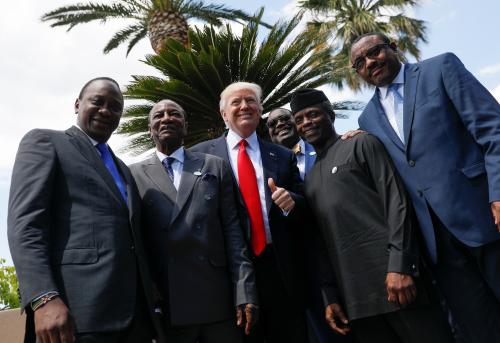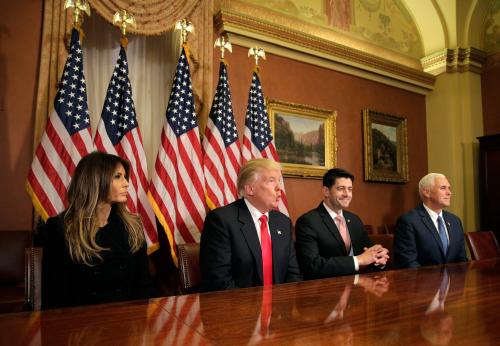The global trade environment is rapidly changing and already affecting the U.S.-Africa trade relationship. Indeed, the African Growth and Opportunity Act (AGOA) was not intended to be permanent. The program was designed as a stepping stone to a more mature trade relationship between the U.S. and the continent. AGOA’s expiration date in 2025 may seem far off but given the complex nature of any trade regime—and the rapidly evolving global trade environment—it is not too soon to begin the complex and difficult work that will provide the foundation for a reciprocal relationship.
In March 2016 the East African community (EAC) took a decision to ban the import of second-hand clothing into the region. The rationale for the ban is the need to protect and promote the textile and leather works industry, which, the EAC reasons, has suffered and failed to develop due to the increased import of second-hand clothing. In response to the proposed ban the U.S.’s Secondary Materials and Recycled Textile Association (SMART) filed a petition with the office of the U.S. Trade Representative (USTR) requesting an assessment of the EAC countries’ continued eligibility under AGOA. In July 2017 the out-of-cycle review commenced and the parties to the dispute were given an opportunity to testify before the USTR.
The EAC receives second-hand clothing from the U.S., the U.K., Germany, South Korea, Belgium, the Netherlands, Canada, Poland, Italy, Japan, India, and Pakistan. Notably, the ban is not discriminatory as it bans all second-hand clothing. The ban has not yet been put in place, but so far some of the East African countries have increased tariffs in an effort to discourage imports on the second-hand clothing with a view of eventually phasing out their import completely.
This trade dispute between the U.S. and EAC closely follows a significant trade dispute with South Africa that involved U.S. imports of poultry products into that market. The dispute over poultry was resolved after Congress threatened to deny AGOA benefits to agricultural products from South Africa. The disputes over second-hand clothing and poultry suggest that the time may be ripe to begin moving toward a more reciprocal trade arrangement with African countries that would include the establishment of a negotiated dispute resolution mechanism as opposed to the arbitrary and unilateral out-of-cycle review that currently exists.
The Trump administration and AGOA
The Trump administration has been supportive of AGOA, provided that participating African governments comply with the eligibility criteria. In a June speech, Commerce Secretary Wilbur Ross said that the U.S. will continue the transition from aid to trade, a position consistent with the Clinton, Bush, and Obama administrations as it relates to commercial policy toward Africa. The Commerce Department has also continued a high-level advisory committee on Africa that was created by President Obama.
U.S. Trade Representative Robert Lighthizer’s opening remarks at the AGOA Forum in Togo last month also signaled the Trump administration’s support for AGOA. In his comments, Lighthizer noted the bipartisan consensus supporting the program but also said there is a need for greater reciprocity in the trade relationship, given the changes that have taken place on the continent. He specifically referenced AGOA partners who are “implementing reciprocal trade agreements with major developed economies.”
Envisioning a post-AGOA relationship
Despite the Trump administration’s apparent support for AGOA, it is important to begin exploring the structure of a post-AGOA relationship. As African countries enter into reciprocal relationships with other countries, especially the EU, U.S. companies and goods will compete at an increasing commercial disadvantage. This growing commercial disadvantage, inevitably, will pressure Congress to act to protect U.S. companies entering African markets, straining the current strong bipartisan consensus in support of AGOA.
In order to ensure an enduring and mutually beneficial trade relationship, the U.S. and the African Union should create a high-level panel to develop a framework and a path forward to a more reciprocal framework when AGOA expires in 2025. This panel, ideally chaired by Ambassador Lighthizer and AU Trade Commissioner Fatima Haram Acyl, should solicit a range of opinions and perspectives, including from academia, think tanks, private sector representatives, and members of civil society. A progress report on their deliberations would be an important part of the next AGOA Forum.
A changing landscape
There are a number of reasons for beginning to plan for the transition to a reciprocal U.S.-African trade relationship. Africa has committed to creating a Comprehensive Free Trade Agreement by the end of 2017, and three regional economic communities—SADC, EAC, and COMESA—have already formed the Tripartite Free Trade area. Africa’s progress on regional integration needs to be reflected in any new trade relationship with the U.S. to ensure that it is mutually beneficial supportive of the region’s integration efforts.
In addition, the European Union is currently negotiating Economic Partnership Agreements (EPAs) with 41 African countries through different blocs. Some EPAs have been have been signed and are now in force while some are still being negotiated. As the 2017 National Trade Estimate Report on Foreign Trade Barriers points out, “The EU-SADC EPA will further erode U.S. export competitiveness in South Africa and the region due to the greater disparities in tariff levels that U.S. exports will face under the EPA.” As the other EPAs take hold across the continent, the disparities adversely affecting American companies will intensify. And, of course, China, as Africa’s largest trading partner, adds to the pressures on U.S. commercial competitiveness in Africa. A new trade relationship between the U.S. and African nations would codify measures related to market access that would provide American companies with more certainty, which would be helpful in competing with Chinese companies.
From the U.S. side, Congress will have to develop a structure for a trade agreement that takes into account Africa’s development priorities. At the same time, market access for goods and services, government procurement, and dispute resolution mechanisms, among other issues, will need to be consistent with those arrangements that Africa’s other trade partners enjoy.
Africa’s negotiating capability
The days of non-reciprocal trade arrangements are gone. The successfully negotiated EPAs between the EU and different African regions indicate the ability of African countries to negotiate reciprocal trade agreements with the developed world. The EPAs that have been concluded thus far have struck a balance between creating trade opportunities for goods from both regions as well as placing measures to protect sensitive products in African countries.
AGOA has had its winners and losers: There are countries that have benefitted greatly from AGOA while many have not taken advantage of the program’s wide range of eligible products. One needs to only look at the trade volumes between the AGOA-eligible countries and the U.S to note the disparities between the volumes of trade between certain African countries and the U.S. A post-AGOA relationship should be one that is beneficial to all parties. An analysis of the constraints of those countries that have not fully utilized AGOA is a necessary exercise and should be part of our proposed high-level U.S.-AU panel.
For some countries, particularly the least-developed countries, there may be a need for agreements with a stronger emphasis on investment while for others a reciprocal agreement granting market access with specific limits will suffice. There may also be a need to negotiate with sub-Saharan African countries within different regional groupings as opposed to trying to negotiate with the continent as a whole in order to ensure that the varied interests are sufficiently covered. When AGOA was extended in 2015, eligible countries were asked to formulate AGOA strategies. These strategies can be used to inform how the countries should be grouped in negotiating the post AGOA relationship, and they should be completed by all AGOA beneficiaries. The time is now to begin planning for the next phase of the U.S.-African trade relationship.







Commentary
Post-AGOA: Moving to a reciprocal US-Africa trade arrangement
September 19, 2017